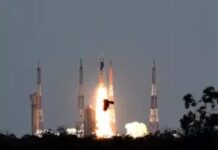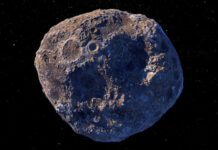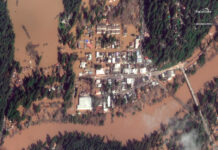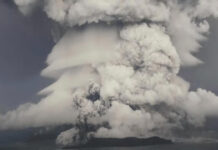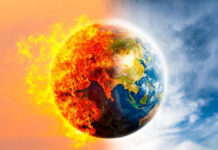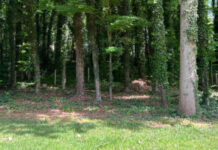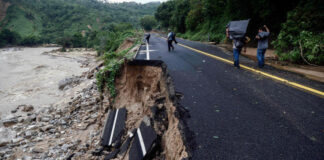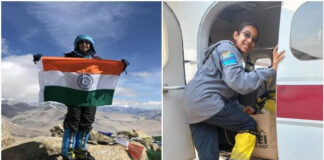JANUARY 16, 2022
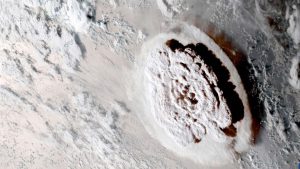
Satellite imagery shows the eruption of the Hunga Tonga-Hunga Ha’apai volcano in the Pacific on Jan. 15, 2022. – Rammb/Noaa/Nesdis Handout/EPA-EFE/REX/Shutterstock
The Hunga Tonga volcano in the southwest Pacific erupted explosively on Saturday evening local time, producing a tsunami, sending ash 100,000 feet high and generating an atmospheric shock wave that rippled around the globe. The eruption was heard in Alaska, about 5,000 miles away, while an area the size of New England was blanketed by the ashen smoke plume.
The volcano is about 40 miles north of Tonga’s main island, Tongatapu, near the international date line. Tonga, home to 105,000 people, can be found northeast of New Zealand and southeast of Fiji.
“We have a nightmare situation of an isolated community experiencing the effects of a large volcanic ash plume producing significant volcanic lightning, as well as a tsunami,” Janine Krippner, a volcanologist at the Smithsonian Global Volcanism Program, wrote in a Twitter direct message. “Seeing that ash plume, that volcanic lightning, and that tsunami leave me feeling sick thinking about the people being impacted by this large eruption.”
In addition to the more immediate and striking atmospheric effects resulting from the volcano, some have speculated that the volcano could affect Earth’s climate. While experts are skeptical, atmospheric scientists continue to collect more data.
The eruption
Hunga Tonga, an underwater volcano, erupted in 2009 and in late 2014. Renewed eruptions ensued Dec. 21, 2021, with occasional spurts of activity during the following weeks. A particularly explosive eruption occurred Jan. 15, resulting in arguably the most remarkable and striking display of volcanic power captured on weather satellite.
The plume towered to about 100,000 feet, roughly three times the altitude at which commercial aircraft fly. Thunderstorms flatten out at the tropopause, or top of the troposphere, the lowest level of Earth’s atmosphere, since a lid of warm air suppresses continued upward development. Hunga Tonga’s plume, however, was so buoyant that it was able to penetrate this layer and continue into the stratosphere before pockets of air and ash subsided once again. The bulge in the middle of the cloud mass where this occurs is known as the “overshooting top.”
Satellite imagery captured “gravity waves” rippling outward from where the plume punctured this ceiling-like layer in the lower atmosphere — like wavelets surrounding a stone tossed in a pond.
A prolific volcanic thunderstorm
Within six hours of the initial blast, the ash and smoke plume from Hunga Tonga covered an area larger than New England. Though night had fallen, the plume would have been thick enough to extinguish the sun. Static discharges within the plume, which towered twice as high as Earth’s most fierce thunderstorms, yielded prolific barrages of volcanic lightning.
Lightning detection networks and satellites tallied more than 60,000 strikes in 15 minutes following the volcano’s initial blast, corresponding to nearly 70 lightning strikes per second. Few, if any, conventional thunderstorms could compare.
Notice, too, the bull’s eye-like pattern that emerges in lightning data. That’s the result of the aforementioned gravity waves. As the waves pass by, upward motion is locally enhanced, boosting lightning rates. In their wake, air sinks, suppressing lightning activity.
A dangerous tsunami
The blast was powerful enough to generate a tsunami of several feet in Tonga and prompted tsunami advisories across Hawaii, Alaska, British Columbia and much of North America’s West Coast, including in Washington, Oregon and California.
A four-foot spike in water levels was observed in Port St. Luis, Calif., and Arena Cove, Calif., reported a 3.5-foot jump. Crescent City, Calif., got a 2.7-foot spike, and a tsunami of 2.8 feet was seen in King Cove, Alaska.
In addition to an uptick in water levels, tsunamis can produce dangerous and erratic currents. They move across oceans faster than commercial jetliners.
Volcano’s explosion heard in Alaska
Experts at the National Weather Service in Anchorage and University of Alaska Fairbanks confirmed that audible booms heard in the state early Saturday morning local time originated from the volcano. That means the sound traveled more than 5,000 miles.
“Dog and I woke up suddenly at 3:30 and now I know why,” tweeted Shan Cole, a writer based in Anchorage.
That means the sound traveled close to 800 mph, and instruments confirmed that much of the noise produced did fall within the spectrum of what humans can hear. That no sound was heard in Hawaii, closer to the volcano, suggests that atmospheric conditions in or near Alaska played a role in reflecting the sound to the surface.
An atmospheric shock wave
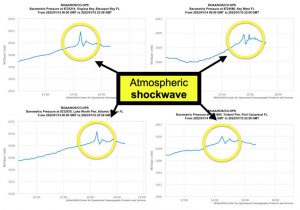
An air pressure trace from a number of stations in Florida depicting the atmospheric shock wave as it rolled through. (NOAA/Matthew Cappucci)
In the initial satellite imagery surrounding the volcano, it’s easy to spot a ring of white radiating rapidly outward far ahead of the volcanic plume. That’s the atmospheric shock wave.
That shock wave traveled around the world, also moving faster than the speed of sound. In Florida, for instance, it could be detected as a perturbation in air pressures shortly after 9 a.m. That’s because the wave briefly spurred a jump in air pressure, meaning the atmosphere briefly weighed more as the wave rolled through.
Daryl Herzmann of Iowa State University compiled air-pressure data from sensors across the Lower 48 to illustrate the wave rolling across the country.
Potential climate impacts
Volcanic eruptions can release enormous amounts of sulfur dioxide and aerosols that, in large enough quantities, can cool the planet and work to snuff out a La Niña pattern. While there was initial speculation that material released by Hunga Tonga could have a similar effect, some experts were quick to point to the magnitude of its release being simply too comparatively minute.
Simon Carn, a professor at Michigan Tech, tweeted that “so far, the [sulfur dioxide] columns do not appear to be extreme.” It would need to be five to 10 times as dense to begin to have a measurable climate impact.
Alan Robock, a professor in the Department of Environmental Sciences at Rutgers, noted that the amount of sulfur dioxide needed to cool Earth would need to be immense.
“Only if the eruption injects a lot of SO2 into the stratosphere, at least 1000 [kilotons, or thousands of tons] or more, will there be a climate impact,” he wrote via email.
Satellite measurements show SO₂ quantities from the latest eruption were 400 kilotons. Robock said the eruption will “produce about 1/50 of the impact of the 1991 Pinatubo eruption,” or about 0.02 degrees (0.01 degree Celsius) average cooling.
Still, experts point to continued eruptions as something to monitor.
“We have no way of knowing when this eruption will be over,” Krippner wrote.
Courtesy/Source: Washington Post












